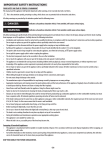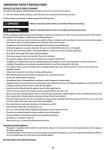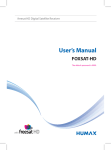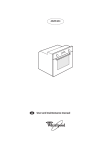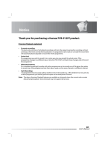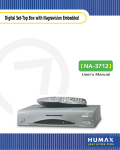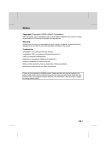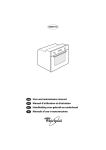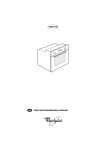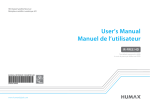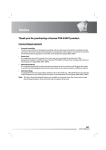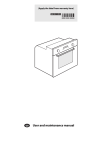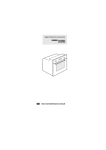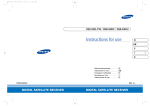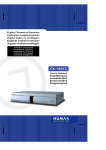Download User`s Manual
Transcript
HD Digital Satellite Set-Top Box User’s Manual HDCI-5000 The default password is 0000. Notice Thank you for purchasing a HUMAX product. Please read this user’s manual carefully to be able to safely install, use and maintain the product at maximum performance. Keep this user’s manual next to your product for future reference. The information in this user’s manual is subject to change without notice. Copyright (Copyright © 2009 HUMAX Corporation) Not to be copied, used or translated in part or whole without HUMAX’s prior consent in writing except approval of ownership of copyright and copyright law. Warranty The warranty does not cover parts which may become defective due to misuse of the information contained in this manual. Trademarks Manufactured under license from Dolby Laboratories. Dolby and the double-D symbol are trademarks of Dolby Laboratories. GB1 Notice Warnings, Cautions and Notes Throughout the whole manual, pay special attention to the following marks that indicate hazardous situations. • Warning Indicates a hazardous situation which could result in serious injury. • Caution Indicates a situation which could damage the equipment or other apparatus. • Note Indicates additional information to make the user aware of possible problems and information of any importance to help understand, use and maintain the installation. Meaning of Symbols To reduce the risk of electric shock, do not remove cover (or back). No user serviceable parts inside. Refer servicing to qualified service personnel. This symbol indicates dangerous voltage inside the product that presents a risk of electric shock or personal injury. This symbol indicates important instructions accompanying the product. Instruction about the ‘WEEE’ Symbol This product should not be disposed with other household wastes at the end of its working life. Please separate this from other types of wastes and recycle it responsibly to promote the sustainable reuse of material resources. This will prevent possible harm to the environment or human health from uncontrolled waste disposal. • Domestic users: Please contact either the retailer where you purchased this product or their local government office for details of where and how they can take this item for environmentally safe recycling. • Business users: Contact your supplier and check the terms and conditions of the purchase contract. This product should not be mixed with other commercial wastes for disposal. GB2 Safety Warning This product has been manufactured to comply with international safety standards. Please read the following safety precautions carefully. Safety Instructions and Precautions 1. MAINS SUPPLY 90-250V a.c., 50/60Hz • • Operate this product only from the type of power supply indicated on the marking label. If you are not sure of the type of power supplied to your home, consult your local power company. Disconnect the product from the mains before you start any maintenance or installation procedures. 2. OVERLOADING • Do not overload a wall outlet, extension cord or adapter as this may result in electric fire or shock. 3. LIQUID • The product should not be exposed to liquid of any kind. In addition, no objects filled with liquid should be placed on the apparatus. 4. CLEANING • • Disconnect the product from the wall outlet before cleaning. Use a light damp cloth (no solvents) to dust the product. 5. VENTILATION • • • The slots on top of the product must be left uncovered to allow proper airflow into the unit. Do not stand the product on soft furnishings or carpets. Do not stack electronic equipments on top of the product. 6. ATTACHMENTS • Do not use any unsupported attachments as these may be hazardous or cause damage to the product. 7. CONNECTION TO THE SATELLITE DISH LNB • Disconnect the product from the mains before connecting or disconnecting the cable from the satellite dish. Failure to do so can damage the LNB. 8. CONNECTION TO THE TV • Disconnect the product from the mains before connecting or disconnecting the cable from the TV. Failure to do so can damage the TV. GB3 Safety Warning 9. EARTHING • The LNB cable must be earthed to the system earth for the satellite dish. 10. LOCATION • • • • • • • Place the product indoors to avoid exposing it to lightning, rain or sun. Do not place it near a radiator or heat register. Make sure it has more than 10 cm clearance from any appliances susceptible to electromagnetic influences, such as a TV or a VCR. Do not block the openings with any object, and do not place the product on a bed, sofa, rug, or other similar surface. If you place the product on a rack or a bookcase, ensure that there is adequate ventilation and that you have followed the manufacturer’s instructions for mounting. Do not place the product on an unstable cart, stand, tripod, bracket, or table where it can fall. A falling product can cause serious injury to a child or adult, and serious damage to the appliance. 11. LIGHTNING, STORM OR NOT IN USE • Unplug the product from the wall outlet and disconnect the antenna during a thunderstorm or when left unattended and unused for long periods of time. This will prevent damage to the unit due to lightning and power-surges. 12. EXTRANEOUS OBJECTS • Do not insert anything through the openings in the unit, where they can touch dangerous voltage points or damage parts. 13. REPLACEMENT OF PARTS • GB4 When replacement of parts is required, be sure the service technician uses replacement parts specified by the manufacturer or those that have the same characteristics as the original part. Unauthorized substitution may result in additional damage to the unit. Safety Warning Warning 1. To avoid damage of the power cord or plug; • • • • • Do not modify or process the power cord or plug arbitrarily. Do not bend or twist the power cord. Make sure to disconnect the power cord holding the plug. Keep heating appliances as far as possible from the power cord in order to prevent the cover vinyl from melting. The mains plug, as a disconnection device, shall remain readily accessible by the user. 2. To avoid electrical shock; • • • Do not open the main body. Do not insert metal or inflammable objects inside the product. Do not touch the power plug with wet hands. Disconnect the power cord in case of lightning. 3. To avoid damage of product; • • Do not use the product when it is out of order. If you continue to use the product when defective, serious damage can be caused to it. Make sure to contact your local product distributor if the product is out of order. Do not insert metal or alien substance into the slots for the modules or Smartcards. It may cause damage to the product and reduce its life span. GB5 Contents 1. Before Using the Product. 1.1 Package Contents. . . 1.2 Front Panel . . . . . . 1.3 Conditional Access . . 1.4 Rear Panel . . . . . . 1.5 Remote Control. . . . . . . . . . . . . . . . . . . . . . . . . . . . . . . . . . . . . . . . . . . . . . . . . . . . . . . . . . . . . . . . . . . . . . . . . . . . . . . . . . . . . . . . . . . . . . . . . . . . . . . . . . . . . . . . . . . . . . . . . . . . . . . . . . . . . . . . . . . . . . . . . . . . . . . . . . . . . . . . . . . . . . . . . . . . . . . . . . . . . . . . . . . . . . . . . GB7 . GB7 . GB8 . GB9 . GB10 . GB11 2. Setup . . . . . . . . . . . . . . . . . . . . . . . . . . . . . . . . . . . . . . . . . . . . . . . . . . . .GB13 2.1 Connecting the TV and VCR . . . . . . . . . . . . . . . . . . . . . . . . . . . . . GB13 2.2 Powering On . . . . . . . . . . . . . . . . . . . . . . . . . . . . . . . . . . . . GB17 3. Installation Wizard . . . . . . . . . . . . . . . . . . . . . . . . . . . . . . . . . . . . . . . . . . . .GB18 4. Basic Operation . . . . . . . . . . . . . . . . . . . . . . . . . . . . . . . . . . . . . . . . . . . . . .GB21 5. Channel List . . . . . . . . . . . . . . . . . . . . . . . . . . . . . . . . . . . . . . . . . . . . . . . .GB23 6. TV Guide . . . . . . . . . . . . . . . . . . . . . . . . . . . . . . . . . . . . . . . . . . . . . . . . . .GB24 7. Menu . . . . . . . . 7.1 Preferences . . 7.2 Edit Channels. 7.3 Installation . . 7.4 System . . . . . . . . . . . . . . . . . . . . . . . . . . . . . . . . . . . . . . . . . . . . . . . . . . . . . . . . . . . . . . . . . . . . . . . . . . . . . . . . . . . . . . . . . . . . . . . . . . . . . . . . . . . . . . . . . . . . . . . . . . . . . . . . . . . . . . . . . . . . . . . . . . . . . . . . . . . . . . . . . . . . . . . . . . . . . . . . . . . . . . . .GB25 . GB25 . GB26 . GB27 . GB31 8. Software Update . . . . . . . . . . . . . . . . . . . . . . . . . . . . . . . . . . . . . . . . . . . . .GB32 8.1 OTA (Over the Air) . . . . . . . . . . . . . . . . . . . . . . . . . . . . . . . . . GB32 9. Appendix . . . . . . . . . . . . . . . . . . . . 9.1 Specification . . . . . . . . . . . . 9.2 Service and Support . . . . . . . . 9.3 OPEN SOURCE SOFTWARE NOTICE. . GB6 . . . . . . . . . . . . . . . . . . . . . . . . . . . . . . . . . . . . . . . . . . . . . . . . . . . . . . . . . . . . . . . . . . . . . . . . . . . . . . . . . . . . . . . . . . . . . . . . . . .GB33 . GB33 . GB35 . GB36 1. Before Using the Product This chapter provides detail instructions on the product and its accessories. 1.1 Package Contents Please check all package contents before using your product. Quick Start Guide User Manual www.humaxdigital.com CD Manual Remote Control SCART Cable Quick Guide Batteries HDMI Cable Note: • Faults may occur if the remote control is left without battery for a long time. Always keep the battery inserted in the remote control. • Package contents may vary according to area. GB7 1. Before Using the Product 1.2 Front Panel 1 2 3 4 5 6 1. STANDBY LED Red light is emitted when the product is in standby mode. 2. STANDBY BUTTON Switches between operation and standby modes. 3. TV/RADIO BUTTON Switches between TV and radio modes. 4. CH-/CH+BUTTON Moves the TV/radio channel up or down. 5. TV LED Green light is emitted when the product is in TV mode. 6. RADIO LED Amber light is emitted when the product is in radio mode. 7. CI-MODULE SLOT A slot for a CI-Module Note: GB8 The front panel of the product is subject to change without notice. 7 1. Before Using the Product 1.3 Conditional Access Although some TV and radio channels are free to air, most TV and radio/music channels are available on a subscription basis and can only be enjoyed via a Conditional Access component. 1. Inserting a CI (with Smartcard) A CI-Module looks like a PC map (PCMCIA) for laptops. There are different kinds of CI-Modules, suitable for different coding systems; Irdeto, Conax and more. Additionally to the CI-Module, a Smartcard is needed to decode the channels. 1. 2. 3. 4. Open the right-hand flap on the front panel of the product to expose the card slot. Follow the instructions of the module and insert the Smartcard into the CI-Module. Keep the CI-Module (with the Smartcard) horizontal. Insert the CI-Module into the slot. CI-Module Smartcard GB9 1. Before Using the Product 1.4 Rear Panel 1 2 3 4 5 6 1. LNB IN Connects a satellite antenna cable. 2. LNB OUT Connects another digital satellite re ceiver. 3. TV SCART Connects to the TV using a TV SCART cable. 4. VCR SCART Connects to the VCR or DVD using a VCR SCART cable. 5. VIDEO Connects to the TV or VCR using an RCA cable. 6. AUDIO L/R Connects to the TV or VCR using an RCA cable. Note: GB10 7 8 9 10 11 12 7. COMPONENT(YPbPr) Connects to the TV or VCR using a component cable. 8. COMPONENT SELECT Switch for changing video. (default: YPbPr) 9. S/PDIF Connects to the audio system using an S/PDIF cable. (digital audio) 10. HDMI Connects to the TV using an HDMI cable. 11. USB Host Connects to the USB memory or external HDD. 12. ETHERNET Service port The rear panel of the product is subject to change without notice. 1. Before Using the Product 1.5 Remote Control 1 1. SOURCE Controls the output of TV SCART. 2 2. TV/RADIO Switches between TV and radio modes. 3 3. NUMERIC(0-9) BUTTONS Enters a TV/radio channel number or menu option number. 4 4. OPT+(Option) Displays the channels attributes while watching a programme. 5 6 7 5. EXIT Exits all On-Screen Display (OSD) screens. 6. ARROW BUTTONS Changes the channel, adjusts the audio volume or moves the cursor up, down, left or right. 8 7. COLOUR BUTTONS(R/G/Y/B) Select the colour keys for interactive applications. 9 8. P-/P+ Changes the channel or page. 10 11 12 9. MENU Displays the main menu. 10. SUBTITLE Displays the subtitle language list. 11. TEXT Switches between the teletext and TV modes. 12.WIDE Sets the display format. GB11 1. Before Using the Product 13 13. STANDBY Switches between operation and standby modes. 14. GUIDE Displays the programme guide. 15. BACK Closes and returns to the previous menu and screen. 14 15 16 16. OK Selects a menu or confirms the selected operation. Displays the channel list while watching a programme. 17. V-/V+ Adjusts the audio volume. 17 18 19 20 21 22 Note: GB12 18. i (INFORMATION) Displays the channel and programme information. 19. MUTE Mutes or unmutes the audio temporarily. 20. AUDIO Displays the audio list. 21. SLEEP Sets the sleep time. 22. V-FORMAT Changes the resolution of video. The remote control of the product is subject to change without notice. 2. Setup This chapter describes how to connect your product to the TV with the particular equipments for gaining optimum signal quality. The product provides various interfaces to connect to the TV, VCR or other devices. Select the most appropriate procedure depending on the equipment you have. Note: If you encounter any problems setting up your product, please contact your local product distributor. 2.1 Connecting the TV and VCR You can select one of the following antenna connections depending on the equipment you have. 1. Using HDMI Cable The HDMI connection is recommended for Digital TV. In case the TV has a HDMI input connector, a special all-digital interface that provides the highest picture quality, connect the product and the TV using a HDMI cable as follows. HDMI Cable HDMI GB13 2. Setup 2. Using DVI Connector The DVI connection using an HDMI to DVI converter is recommended for Digital TV. In case the TV has the DVI input connector only, connect the product to the TV with an HDMI cable using an HDMI to DVI converter as follows. 1. 2. 3. Connect the antenna to the LNB IN. Connect one end of the HDMI cable to the HDMI input on the product and the other end to the HDMI to DVI converter. Connect the DVI converter to the TV. For audio, you can either 4-1. Connect the product and the Dolby Digital decoder using an S/PDIF cable. 4-2. Connect the product and the TV using an RCA cable (Audio L/R). HDMI Cable GB14 2. Setup 3. Using Component Cable The component connection is recommended for Digital TV. Connect the product and the TV using a component cable as follows. You can either: • 1-1 Connect the product and the TV using an RCA cable (Audio L/R). • 1-2 Connect the product and the Dolby Digital decoder using an S/PDIF cable. Note: The Component Select switch should be on YPbPr when using the component cable. RCA Cable Component Cable S/PDIF Cable AUDIO COMPONENT IN S/PDIF L R GB15 2. Setup 4. Using SCART Cable A SCART cable connection is recommended for analogue TV or VCR. 1. 2. Connect the product and the TV using a SCART cable. Connect the product and the VCR using a SCART cable. Note: The Component Select switch should be on RGB when using the SCART cable. SCART Cable SCART Cable VCR SCART GB16 TV SCART 2. Setup 2.2 Powering On 1. 2. Connect the power cord of the product to a wall outlet. Power on by pressing the STANDBY button of the remote control or the STANDBY button at the front of the product. GB17 3. Installation Wizard When powering on your product for the first time after purchase, the installation wizard will operate automatically. Tip: The default password is 0000. If you have forgotten your password, please contact your local product distributor. 1. Language Select the appropriate language from the list. 2. Time Zone Select the country. If you have selected Other, select the appropriate time zone. 3. Antenna Type Select Fixed Antenna if you are using a fixed antenna and select SCD Antenna if you are using a single cable system antenna. GB18 3. Installation Wizard 4. Default Channels The satellites of the default channel list which belong to the country you have selected will appear. Select Yes to go to the display menu or select No to move to antenna setting. 5. Antenna Setting Configure the antenna setting parameters. 6. Search Channels Channel search will activate and the results will appear. GB19 3. Installation Wizard 7. Display Select the value for Screen Ratio, Display Format and Resolution. 8. Result After all setting is complete, you can view the result screen. Select Finish to complete the installation wizard. GB20 4. Basic Operation This chapter describes the basic functions the product provides such as switching channel, volume control and other common features. 1. Switching Channel You can switch the current channel by pressing the P-/P+ button or entering the channel number directly using the NUMERIC(0-9) buttons. 2. Volume Control Press the V-/V+ button to adjust the audio volume. Press the MUTE button to stop the audio temporarily. 3. Resolution Press the V-FORMAT button while watching a programme. The current resolution will be displayed. Each time you press the V-FORMAT button, the resolution changes. 4. Sleep Press the SLEEP button while watching a programme to set the sleep time. Each time you press the SLEEP button, the sleep time changes. 5. Wide You can set the display format. Press the WIDE button while watching a programme to change the display format. Each time you press the WIDE button, the display format changes. 6. Audio Press the AUDIO button and select the audio language you prefer. Select audio direction (left, right, stereo) using the / button. 7. Subtitle Press the SUBTITLE button and select the required subtitle language and press the OK button. The subtitle will be displayed in the selected language at the bottom of the screen. GB21 4. Basic Operation 8. Teletext Press the TEXT button. To display the teletext menu, press the MENU button in teletext mode. Select the teletext function you want and press the OK button. 9. Programme Information (i-plate) The i-plate is always displayed for a certain period of time whenever you switch channels. Press the i button while watching a programme. Press the i button again to view detailed information. GB22 5. Channel List This chapter will help you manipulate the channel list. You can display the channel list by pressing the OK button while watching a programme. My TV (RED) • • • • TV: The list of all TV channels. Radio: The list of all radio channels. HD TV: The list of all HD TV channels. Recently Viewed: The list of the recently viewed channels. Favourite (GREEN) The list of the favourite channels in five groups. • Most Viewed: The list of the most watched channels. Satellite (YELLOW) The lists of channels classified by satellites. Scramble (BLUE) The lists of channels classified by CAS types. Select the channel you wish to view and press the OK button. You can also enter the channel number using the NUMERIC(0-9) buttons. Note: You can switch between TV and radio by simply pressing the TV/RADIO button. GB23 6. TV Guide TV Guide displays the programme information of each channel, in time and date order. You can customize your own programme guide to list the channels or programmes of interest to you and schedule your viewing using the programme information. 1. Table Guide You can view the programme information of all channels in time and date order. 2. List Guide EPG List displays the programme information for approximately a week. 3. Schedule Schedule displays the list of the programmes reserved. You can modify, delete or make new reservations. 4. Find Find enables you to find the programme you want by entering the genre, name, time and day of the programme. GB24 7. Menu 7.1 Preferences In this chapter you can set parental control, language setting, time setting, A/V setting and other configuration items to keep limitations where you want them for the viewers. 1. Parental Control Age Limit, Change Password, Installation Lock 2. Language Setting Menu Language, Subtitle Display, Subtitle Font 3. Time Setting Country, GMT Offset, Daylight Saving Time, Power ON, Power On Channel, Power OFF 4. A/V Setting TV SCART, VCR SCART, Audio Output, Dolby Digital Auto Selection, Lip-Sync, Screen Ratio, Display Format, Letter and Pillar Box Colour 5. Other Settings Info Display Time, OSD Transparency, Power Saving in Standby GB25 7. Menu 7.2 Edit Channels In this chapter you can edit all channels in the channel list or make changes to the favourite lists of the channels you have chosen. 1. Edit Channel List You can delete, move, select, rename or lock/unlock the channels in the channel list conveniently. 2. Edit Favourite List You can add or remove channels from the favourite groups, move favourite channels, rename favourite groups and move the favourite groups. 3. Import/Export Channels The channel data can be imported from the USB to the receiver or exported from the receiver to a USB device (such as USB memory stick). The file format of the channel data is .udf format. 1. Download the Uniformula programme into your PC (http://www.humaxdigital.com) and install the Uniformula. 2. Connect the USB to the PC and then to the receiver. 3. Select Import Channels from USB using the / button and press the OK button. Note: For more information about how to use the Uniformula, refer to the Help>Contents menu in the Uniformula. 4. Display History List You can choose to display the history list in the channel list. GB26 7. Menu 7.3 Installation In this chapter you can configure the installation setting and perform channel search. Menus such as antenna setting, search channels, software update and default setting are included in this section. 1. Antenna Setting [Fixed] MENU Installation Antenna Setting [Fixed] You can set the antenna and LNB information for channel search. If the antenna is not properly set, channel search cannot be activated which means you cannot watch any of the programmes on air. 1. Antenna Type Select Fixed Antenna. 3. Satellite Setting Enter the value for Satellite, LNB Frequency, 22kHz Tone, DiSEqC Input, LNB Power, Transponder and save. Select Search and press the OK button to go to search channels. 3. Transponder Transponder setting is normally fixed. Change the setting only when necessary. To change the transponder setting, select User Define in Transponder and enter the value for Frequency, Polarisation, Symbol Rate, Transmission, Modulation and FEC. GB27 7. Menu 2. Antenna Setting [SCD Antenna] MENU Installation Antenna Setting [SCD Antenna] 1. Antenna Type Select SCD Antenna. 2. User Band Select from User Band 1-8. 3. Band Frequency When selecting User Band 1-8 in SCD Antenna, the default value is displayed. You can also enter the Band Frequency directly. 4. Satellite Setting Enter the value for Satellite, LNB Frequency, LNB Power, Satellite Position, Transponder and save. Select Search and press the OK button to go to search channels. GB28 7. Menu 3. Antenna Setting [Motor] MENU Installation Antenna Setting [Motor] 1. Antenna Type Select Motor Antenna. 2. Satellite Setting • Motor Setting Enter the value for LNB Frequency, LNB Power, Motor Type, My Longitude and My Latitude. • Edit Satellite Data Enter the value for Satellite, Activate Satellite and Satellite Longitude. • Position Setting Enter the value for Satellite, Transponder, Motor Driving, and Driving Size. • Limit Setting Enter the value for Motor Limit and Limit Position. Select Search and press the OK button to go to search channels. GB29 7. Menu 4. Antenna Setting [SMATV] MENU Installation Antenna Setting [SMATV] 1. Antenna Type Select SMATV. Select Search and press the OK button. 2. Automatic Search Enter the value for Scrambled Type, Start Frequency, End Frequency and Symbol Rate (1)-(4). 3. Manual Search Enter the value for Scrambled Type, Frequency, Symbol Rate, Transmission, Modulation and FEC. Select Search and press the OK button to start channel search. 5. Software Update MENU Installation Software Update 1. Automatic Update When new software is detected, you can choose to download the software immediately or save for later. 2. Manual Update Enter the value for Satellite, Frequency, Polarsation, Symbol Rate, Transmission, Modulation and FEC. GB30 7. Menu 6. Default Setting MENU Installation Default Setting You can restore the product to the factory default. 7.4 System 1. Status You can view the model name, software version, loader version, system ID, update date, Micom version and MAC address of the product. The CI-Module slot is also displayed. 2. Signal Detection You can view the satellite, transponder information, signal strength and quality of the tuner. 3. Common Interface You can view the CI-Module information. GB31 8. Software Update In order to maintain proper performance of the product, it is essential to have the most up-to-date software. Visit the Humax website to check the latest news and newly released software versions. (http://www.humaxdigital.com) It is recommended that you periodically check for the availability of software update. 8.1 OTA (Over the Air) OTA, an abbreviation of Over-the-Air, is a standard for the transmission of software through a broadcast system. OTA is simply an alternative method for downloading software versions. However, the manufacturers reserve the right for deciding the release of the software for their products by beaming the latest software versions over the air via satellite. Note that OTA is only limited to certain geographical regions mainly due to different antennas having different footprints (area where the signal can be received). The software update via satellite will only occur under the following circumstances. 1. The equipment should have the appropriate loader software. Please note that if the normal loader software is not equipped, the product may not be updated or operate properly after software update. The manufacturer decides to release the software via a designated satellite. The equipment must be tuned properly to the same antenna equivalent to that of the manufacturer. Update software when the signal strength and quality is high. If the weather is not favorable, and the signal strength and quality are not recommendable, perform the software update later. Caution: 2. 3. 4. Caution: • Please be careful to keep the power on and the power cord plugged in during software update. If the power is off during software update, fatal damage may be caused to the product. • Please be careful not to pull out the signal line (LNB cable) during software update. Update may be interrupted and the product may not operate. Note: • It may take 5~10 minutes to update software. • Other functions will not activate while software update takes place. • You cannot schedule programmes during software update. GB32 9. Appendix 9.1 Specification Tuner & Channel No of Tuners 1 Input Connector F-Type, IEC 169-24, Female Frequency Range 950MHz to 2150MHz Signal Level -25 to -75dBm LNB Power & Polarisation Vertical : +13.5V (+14.5V at high voltage) Horizontal : +18V (+18.5V at high voltage) Current : Max. 500mA (Overload protection) 22KHz Tone Frequency : 22 ± 4KHz Amplitude : 0.7 ± 0.2V DiSEqC Control Version1.0, 1.2, USALS, SCD (Single Cable Distribution) Demodulation QPSK, 8PSK Input Symbol Rate DVB-S : 2-45Ms/s DVB-S2 : 10-30Ms/s (QPSK), 10-31Ms/s (8PSK) FEC Mode DVB-S: Auto,1/2,2/3,3/4,5/6,7/8 DVB-S2: Auto,1/2,3/5,2/3,4/5,5/6,8/9,9/10 (QPSK) Auto,3/5,2/3,3/4,5/6,8/9,9/10 (8PSK) MPEG Transport Stream A/V Decoding Transport Stream MPEG-2 ISO/IEC 13818 Transport Stream Specification Profile Level MPEG-2MP@ML, MPEG-2MP@HL, MPEG-4 HP@L4 .1 Input Rate 15MB/s Max Video Format 4:3, 16:9 Video Resolution 1080i, 720p, 576p, 576i Audio Decoding MPEG/MusiCam Layer I & II, AC3 downmix Audio Mode Single channel/Dual channel/Joint stereo/Stereo GB33 9. Appendix Memory Flash Memory 8MB RAM 128MB EEPROM 8KB Audio/Video/Data In/Out Video TV-SCART(CVBS,S-Video,RGB) VCR-SCART(CVBS, S-Video) RCA-Type(CVBS), YPbPr(RCA), HDMI Audio TV-SCART, VCR-SCART, Audio L/R, S/PDIF(Digital Audio Output) Data Port USB USB 2.0 Host (5 V 100mA Max.) Power Supply Input Voltage 90-250V a.c., 50/60Hz Type SMPS Power Consumption Max. 30W Protection Separate internal fuse. The input should be protected against lightning. Physical Specification Size 310mm × 60mm × 237mm Weight (Net) 1.8Kg Operating Temperature 0 ºC to +45 ºC Storage Temperature -10 ºC to +70 ºC GB34 9. Appendix 9.2 Service and Support Information concerning troubleshooting, software upgrade and product support is provided in the following websites and call centers. Should your product require warranty service, please contact HUMAX to obtain the appropriate authorization. Deutschland Tel: Öffnungszeiten: E-mail: Website: Sprache: 01805-778870 (€ 0,14/Min) Mo-Fr 8:00-23:00 Uhr, Sa-So 8:00-20:00 Uhr [email protected] www.humax-digital.de Deutsch/Englisch/Türkisch UK Tel: Opening Hours: E-mail: Website: Language: 0870 247 8800 Mon-Fri 8:30-21:00 [email protected] www.humax-digital.co.uk English Italia Tel: Orario: Lingua: 899 100 080 (€1+ VAT/min) Lun.-Ven. 8:00-18:00 Italiano Sverige Tfn: Öppettider: Språk: +46 (0)550 85527 Mån-fre 08:00-16:30 Svenska/engelska Suomi Puh: Aukioloajat: Kieli: +358 9 56186 130 ma-pe 8:00-16:00 Suomi/Englanti Austria Tel: Opening Hours: E-mail: Website: Language: Note: 0820 400675 (€0,14/min) Mon-Sun 8:00-23:00 [email protected] www.humax-digital.de Deutsch/English/Turkish For hardware repair, please visit our website. GB35 9. Appendix 9.3 OPEN SOURCE SOFTWARE NOTICE HUMAX products use certain open source operating system software distributed pursuant to GNU GENERAL PUBLIC LICENSE Version 2 and GNU LESSER GENERAL LICENSE Version 2.1 each as defined and published by the Free Software Foundation, Inc. The following GPL and LGPL software source codes used in this product can be provided. Please contact us at [email protected]. GPL Software linux busybox LGPL Software uClibc The GNU General Public License (GPL) Version 2, June 1991 Copyright (C) 1989, 1991 Free Software Foundation, Inc. 51 Franklin Street, Fifth Floor, Boston, MA 02110-1301, USA Everyone is permitted to copy and distribute verbatim copies of this license document, but changing it is not allowed. Preamble The licenses for most software are designed to take away your freedom to share and change it. By contrast, the GNU General Public License is intended to guarantee your freedom to share and change free software--to make sure the software is free for all its users. This General Public License applies to most of the Free Software Foundation’s software and to any other program whose authors commit to using it. (Some other Free Software Foundation software is covered by the GNU Lesser General Public License instead.) You can apply it to your programs, too. When we speak of free software, we are referring to freedom, not price. Our General Public Licenses are designed to make sure that you have the freedom to distribute copies of free software (and charge for this service if you wish), that you receive source code or can get it if you want it, that you can change the software or use pieces of it in new free programs; and that you know you can do these things. To protect your rights, we need to make restrictions that forbid anyone to deny you these rights or to ask you to surrender the rights. These restrictions translate to certain responsibilities for you if you distribute copies of the software, or if you modify it. For example, if you distribute copies of such a program, whether gratis or for a fee, you must give the recipients all the rights that you have. You must make sure that they, too, receive or can get the source code. And you must show them these terms so they know their rights. We protect your rights with two steps: (1) copyright the software, and (2) offer you this license which gives you legal permission to copy, distribute and/or modify the software. Also, for each author’s protection and ours, we want to make certain that everyone understands that there is no warranty for this free software. If the software is modified by someone else and passed on, we want its recipients to know that what they have is not the original, so that any problems introduced by others will not reflect on the original authors’ reputations. GB36 9. Appendix Finally, any free program is threatened constantly by software patents. We wish to avoid the danger that redistributors of a free program will individually obtain patent licenses, in effect making the program proprietary. To prevent this, we have made it clear that any patent must be licensed for everyone’s free use or not licensed at all. The precise terms and conditions for copying, distribution and modification follow. TERMS AND CONDITIONS FOR COPYING, DISTRIBUTION AND MODIFICATION 0. This License applies to any program or other work which contains a notice placed by the copyright holder saying it may be distributed under the terms of this General Public License. The “Program”, below, refers to any such program or work, and a “work based on the Program” means either the Program or any derivative work under copyright law: that is to say, a work containing the Program or a portion of it, either verbatim or with modifications and/or translated into another language. (Hereinafter, translation is included without limitation in the term “modification”.) Each licensee is addressed as “you”. Activities other than copying, distribution and modification are not covered by this License; they are outside its scope. The act of running the Program is not restricted, and the output from the Program is covered only if its contents constitute a work based on the Program (independent of having been made by running the Program). Whether that is true depends on what the Program does. 1. You may copy and distribute verbatim copies of the Program’s source code as you receive it, in any medium, provided that you conspicuously and appropriately publish on each copy an appropriate copyright notice and disclaimer of warranty; keep intact all the notices that refer to this License and to the absence of any warranty; and give any other recipients of the Program a copy of this License along with the Program. You may charge a fee for the physical act of transferring a copy, and you may at your option offer warranty protection in exchange for a fee. 2. You may modify your copy or copies of the Program or any portion of it, thus forming a work based on the Program, and copy and distribute such modifications or work under the terms of Section 1 above, provided that you also meet all of these conditions: a) b) c) You must cause the modified files to carry prominent notices stating that you changed the files and the date of any change. You must cause any work that you distribute or publish, that in whole or in part contains or is derived from the Program or any part thereof, to be licensed as a whole at no charge to all third parties under the terms of this License. If the modified program normally reads commands interactively when run, you must cause it, when started running for such interactive use in the most ordinary way, to print or display an announcement including an appropriate copyright notice and a notice that there is no warranty (or else, saying that you provide a warranty) and that users may redistribute the program under these conditions, and telling the user how to view a copy of this License. (Exception: if the Program itself is interactive but does not normally print such an announcement, your work based on the Program is not required to print an announcement.) These requirements apply to the modified work as a whole. If identifiable sections of that work are not derived from the Program, and can be reasonably considered independent and separate works in themselves, then this License, and its terms, do not apply to those sections when you distribute them as separate works. But when you distribute the same sections as part of a whole which is a work based on the Program, the distribution of the whole must be on the terms of this License, whose permissions for other licensees extend to the entire whole, and thus to each and every part regardless of who wrote it. Thus, it is not the intent of this section to claim rights or contest your rights to work written entirely by you; rather, the intent is to exercise the right to control the distribution of derivative or collective works based on the Program. GB37 9. Appendix In addition, mere aggregation of another work not based on the Program with the Program (or with a work based on the Program) on a volume of a storage or distribution medium does not bring the other work under the scope of this License. 3. You may copy and distribute the Program (or a work based on it, under Section 2) in object code or executable form under the terms of Sections 1 and 2 above provided that you also do one of the following: a) b) c) Accompany it with the complete corresponding machine-readable source code, which must be distributed under the terms of Sections 1 and 2 above on a medium customarily used for software interchange; or, Accompany it with a written offer, valid for at least three years, to give any third party, for a charge no more than your cost of physically performing source distribution, a complete machine-readable copy of the corresponding source code, to be distributed under the terms of Sections 1 and 2 above on a medium customarily used for software interchange; or, Accompany it with the information you received as to the offer to distribute corresponding source code. (This alternative is allowed only for noncommercial distribution and only if you received the program in object code or executable form with such an offer, in accord with Subsection b above.) The source code for a work means the preferred form of the work for making modifications to it. For an executable work, complete source code means all the source code for all modules it contains, plus any associated interface definition files, plus the scripts used to control compilation and installation of the executable. However, as a special exception, the source code distributed need not include anything that is normally distributed (in either source or binary form) with the major components (compiler, kernel, and so on) of the operating system on which the executable runs, unless that component itself accompanies the executable. If distribution of executable or object code is made by offering access to copy from a designated place, then offering equivalent access to copy the source code from the same place counts as distribution of the source code, even though third parties are not compelled to copy the source along with the object code. 4. You may not copy, modify, sublicense, or distribute the Program except as expressly provided under this License. Any attempt otherwise to copy, modify, sublicense or distribute the Program is void, and will automatically terminate your rights under this License. However, parties who have received copies, or rights, from you under this License will not have their licenses terminated so long as such parties remain in full compliance. 5. You are not required to accept this License, since you have not signed it. However, nothing else grants you permission to modify or distribute the Program or its derivative works. These actions are prohibited by law if you do not accept this License. Therefore, by modifying or distributing the Program (or any work based on the Program), you indicate your acceptance of this License to do so, and all its terms and conditions for copying, distributing or modifying the Program or works based on it. 6. Each time you redistribute the Program (or any work based on the Program), the recipient automatically receives a license from the original licensor to copy, distribute or modify the Program subject to these terms and conditions. You may not impose any further restrictions on the recipients’ exercise of the rights granted herein. You are not responsible for enforcing compliance by third parties to this License. 7. If, as a consequence of a court judgment or allegation of patent infringement or for any other reason (not limited to patent issues), conditions are imposed on you (whether by court order, agreement or otherwise) that contradict the conditions of this License, they do not excuse you from the conditions of this License. If you cannot distribute so as to satisfy simultaneously your obligations under this License and any other pertinent obligations, then as a consequence you may not distribute the Program at all. For example, if a patent license would not permit royalty-free redistribution of the Program by all those who receive copies directly or indirectly through you, then the only way you could satisfy both it and this License would be to refrain entirely from distribution of the Program. GB38 9. Appendix If any portion of this section is held invalid or unenforceable under any particular circumstance, the balance of the section is intended to apply and the section as a whole is intended to apply in other circumstances. It is not the purpose of this section to induce you to infringe any patents or other property right claims or to contest validity of any such claims; this section has the sole purpose of protecting the integrity of the free software distribution system, which is implemented by public license practices. Many people have made generous contributions to the wide range of software distributed through that system in reliance on consistent application of that system; it is up to the author/donor to decide if he or she is willing to distribute software through any other system and a licensee cannot impose that choice. This section is intended to make thoroughly clear what is believed to be a consequence of the rest of this License. 8. If the distribution and/or use of the Program is restricted in certain countries either by patents or by copyrighted interfaces, the original copyright holder who places the Program under this License may add an explicit geographical distribution limitation excluding those countries, so that distribution is permitted only in or among countries not thus excluded. In such case, this License incorporates the limitation as if written in the body of this License. 9. The Free Software Foundation may publish revised and/or new versions of the General Public License from time to time. Such new versions will be similar in spirit to the present version, but may differ in detail to address new problems or concerns. Each version is given a distinguishing version number. If the Program specifies a version number of this License which applies to it and “any later version”, you have the option of following the terms and conditions either of that version or of any later version published by the Free Software Foundation. If the Program does not specify a version number of this License, you may choose any version ever published by the Free Software Foundation. 10. If you wish to incorporate parts of the Program into other free programs whose distribution conditions are different, write to the author to ask for permission. For software which is copyrighted by the Free Software Foundation, write to the Free Software Foundation; we sometimes make exceptions for this. Our decision will be guided by the two goals of preserving the free status of all derivatives of our free software and of promoting the sharing and reuse of software generally. NO WARRANTY 11. BECAUSE THE PROGRAM IS LICENSED FREE OF CHARGE, THERE IS NO WARRANTY FOR THE PROGRAM, TO THE EXTENT PERMITTED BY APPLICABLE LAW. EXCEPT WHEN OTHERWISE STATED IN WRITING THE COPYRIGHT HOLDERS AND/OR OTHER PARTIES PROVIDE THE PROGRAM “AS IS” WITHOUT WARRANTY OF ANY KIND, EITHER EXPRESSED OR IMPLIED, INCLUDING, BUT NOT LIMITED TO, THE IMPLIED WARRANTIES OF MERCHANTABILITY AND FITNESS FOR A PARTICULAR PURPOSE. THE ENTIRE RISK AS TO THE QUALITY AND PERFORMANCE OF THE PROGRAM IS WITH YOU. SHOULD THE PROGRAM PROVE DEFECTIVE, YOU ASSUME THE COST OF ALL NECESSARY SERVICING, REPAIR OR CORRECTION. 12. IN NO EVENT UNLESS REQUIRED BY APPLICABLE LAW OR AGREED TO IN WRITING WILL ANY COPYRIGHT HOLDER, OR ANY OTHER PARTY WHO MAY MODIFY AND/OR REDISTRIBUTE THE PROGRAM AS PERMITTED ABOVE, BE LIABLE TO YOU FOR DAMAGES, INCLUDING ANY GENERAL, SPECIAL, INCIDENTAL OR CONSEQUENTIAL DAMAGES ARISING OUT OF THE USE OR INABILITY TO USE THE PROGRAM (INCLUDING BUT NOT LIMITED TO LOSS OF DATA OR DATA BEING RENDERED INACCURATE OR LOSSES SUSTAINED BY YOU OR THIRD PARTIES OR A FAILURE OF THE PROGRAM TO OPERATE WITH ANY OTHER PROGRAMS), EVEN IF SUCH HOLDER OR OTHER PARTY HAS BEEN ADVISED OF THE POSSIBILITY OF SUCH DAMAGES. GB39 9. Appendix END OF TERMS AND CONDITIONS How to Apply These Terms to Your New Programs If you develop a new program, and you want it to be of the greatest possible use to the public, the best way to achieve this is to make it free software which everyone can redistribute and change under these terms. To do so, attach the following notices to the program. It is safest to attach them to the start of each source file to most effectively convey the exclusion of warranty; and each file should have at least the “copyright” line and a pointer to where the full notice is found. One line to give the program’s name and a brief idea of what it does. Copyright (C) yyyy name of author This program is free software; you can redistribute it and/or modify it under the terms of the GNU General Public License as published by the Free Software Foundation; either version 2 of the License, or (at your option) any later version. This program is distributed in the hope that it will be useful, but WITHOUT ANY WARRANTY; without even the implied warranty of MERCHANTABILITY or FITNESS FOR A PARTICULAR PURPOSE. See the GNU General Public License for more details. You should have received a copy of the GNU General Public License along with this program; if not, write to the Free Software Foundation, Inc., 51 Franklin Street, Fifth Floor, Boston, MA 02110-1301, USA. Also add information on how to contact you by electronic and paper mail. If the program is interactive, make it output a short notice like this when it starts in an interactive mode: Gnomovision version 69, Copyright (C) year name of author Gnomovision comes with ABSOLUTELY NO WARRANTY; for details type `show w’. This is free software, and you are welcome to redistribute it under certain conditions; type `show c’ for details. The hypothetical commands `show w’ and `show c’ should show the appropriate parts of the General Public License. Of course, the commands you use may be called something other than `show w’ and `show c’; they could even be mouse-clicks or menu items-whatever suits your program. You should also get your employer (if you work as a programmer) or your school, if any, to sign a “copyright disclaimer” for the program, if necessary. Here is a sample; alter the names: Yoyodyne, Inc., hereby disclaims all copyright interest in the program `Gnomovision’ (which makes passes at compilers) written by James Hacker. signature of Ty Coon, 1 April 1989 Ty Coon, President of Vice This General Public License does not permit incorporating your program into proprietary programs. If your program is a subroutine library, you may consider it more useful to permit linking proprietary applications with the library. If this is what you want to do, use the GNU Library General Public License instead of this License. GNU Lesser General Public License (LGPL) Version 2.1, February 1999 Copyright (C) 1991, 1999 Free Software Foundation, Inc. 51 Franklin Street, Fifth Floor, Boston, MA 02110-1301 USA Everyone is permitted to copy and distribute verbatim copies of this license document, but changing it is not allowed. GB40 9. Appendix [This is the first released version of the Lesser GPL. It also counts as the successor of the GNU Library Public License, version 2, hence the version number 2.1.] Preamble The licenses for most software are designed to take away your freedom to share and change it. By contrast, the GNU General Public Licenses are intended to guarantee your freedom to share and change free software--to make sure the software is free for all its users. This license, the Lesser General Public License, applies to some specially designated software packages--typically libraries--of the Free Software Foundation and other authors who decide to use it. You can use it too, but we suggest you first think carefully about whether this license or the ordinary General Public License is the better strategy to use in any particular case, based on the explanations below. When we speak of free software, we are referring to freedom of use, not price. Our General Public Licenses are designed to make sure that you have the freedom to distribute copies of free software (and charge for this service if you wish); that you receive source code or can get it if you want it; that you can change the software and use pieces of it in new free programs; and that you are informed that you can do these things. To protect your rights, we need to make restrictions that forbid distributors to deny you these rights or to ask you to surrender these rights. These restrictions translate to certain responsibilities for you if you distribute copies of the library or if you modify it. For example, if you distribute copies of the library, whether gratis or for a fee, you must give the recipients all the rights that we gave you. You must make sure that they, too, receive or can get the source code. If you link other code with the library, you must provide complete object files to the recipients, so that they can relink them with the library after making changes to the library and recompiling it. And you must show them these terms so they know their rights. We protect your rights with a two-step method: (1) we copyright the library, and (2) we offer you this license, which gives you legal permission to copy, distribute and/or modify the library. To protect each distributor, we want to make it very clear that there is no warranty for the free library. Also, if the library is modified by someone else and passed on, the recipients should know that what they have is not the original version, so that the original author’s reputation will not be affected by problems that might be introduced by others. Finally, software patents pose a constant threat to the existence of any free program. We wish to make sure that a company cannot effectively restrict the users of a free program by obtaining a restrictive license from a patent holder. Therefore, we insist that any patent license obtained for a version of the library must be consistent with the full freedom of use specified in this license. Most GNU software, including some libraries, is covered by the ordinary GNU General Public License. This license, the GNU Lesser General Public License, applies to certain designated libraries, and is quite different from the ordinary General Public License. We use this license for certain libraries in order to permit linking those libraries into non-free programs. When a program is linked with a library, whether statically or using a shared library, the combination of the two is legally speaking a combined work, a derivative of the original library. The ordinary General Public License therefore permits such linking only if the entire combination fits its criteria of freedom. The Lesser General Public License permits more lax criteria for linking other code with the library. We call this license the “Lesser” General Public License because it does Less to protect the user’s freedom than the ordinary General Public License. It also provides other free software developers Less of an advantage over competing non-free programs. These disadvantages are the reason we use the ordinary General Public License for many libraries. However, the Lesser license provides advantages in certain special circumstances. GB41 9. Appendix For example, on rare occasions, there may be a special need to encourage the widest possible use of a certain library, so that it becomes a de-facto standard. To achieve this, non-free programs must be allowed to use the library. A more frequent case is that a free library does the same job as widely used non-free libraries. In this case, there is little to gain by limiting the free library to free software only, so we use the Lesser General Public License. In other cases, permission to use a particular library in non-free programs enables a greater number of people to use a large body of free software. For example, permission to use the GNU C Library in non-free programs enables many more people to use the whole GNU operating system, as well as its variant, the GNU/Linux operating system. Although the Lesser General Public License is Less protective of the users’ freedom, it does ensure that the user of a program that is linked with the Library has the freedom and the wherewithal to run that program using a modified version of the Library. The precise terms and conditions for copying, distribution and modification follow. Pay close attention to the difference between a “work based on the library” and a “work that uses the library”. The former contains code derived from the library, whereas the latter must be combined with the library in order to run. TERMS AND CONDITIONS FOR COPYING, DISTRIBUTION AND MODIFICATION 0. This License Agreement applies to any software library or other program which contains a notice placed by the copyright holder or other authorized party saying it may be distributed under the terms of this Lesser General Public License (also called “this License”). Each licensee is addressed as “you”. A “library” means a collection of software functions and/or data prepared so as to be conveniently linked with application programs (which use some of those functions and data) to form executables. The “Library”, below, refers to any such software library or work which has been distributed under these terms. A “work based on the Library” means either the Library or any derivative work under copyright law: that is to say, a work containing the Library or a portion of it, either verbatim or with modifications and/or translated straightforwardly into another language. (Hereinafter, translation is included without limitation in the term “modification”.) “Source code” for a work means the preferred form of the work for making modifications to it. For a library, complete source code means all the source code for all modules it contains, plus any associated interface definition files, plus the scripts used to control compilation and installation of the library. Activities other than copying, distribution and modification are not covered by this License; they are outside its scope. The act of running a program using the Library is not restricted, and output from such a program is covered only if its contents constitute a work based on the Library (independent of the use of the Library in a tool for writing it). Whether that is true depends on what the Library does and what the program that uses the Library does. 1. You may copy and distribute verbatim copies of the Library’s complete source code as you receive it, in any medium, provided that you conspicuously and appropriately publish on each copy an appropriate copyright notice and disclaimer of warranty; keep intact all the notices that refer to this License and to the absence of any warranty; and distribute a copy of this License along with the Library. You may charge a fee for the physical act of transferring a copy, and you may at your option offer warranty protection in exchange for a fee. GB42 9. Appendix 2. You may modify your copy or copies of the Library or any portion of it, thus forming a work based on the Library, and copy and distribute such modifications or work under the terms of Section 1 above, provided that you also meet all of these conditions: a) b) c) d) The modified work must itself be a software library. You must cause the files modified to carry prominent notices stating that you changed the files and the date of any change. You must cause the whole of the work to be licensed at no charge to all third parties under the terms of this License. If a facility in the modified Library refers to a function or a table of data to be supplied by an application program that uses the facility, other than as an argument passed when the facility is invoked, then you must make a good faith effort to ensure that, in the event an application does not supply such function or table, the facility still operates, and performs whatever part of its purpose remains meaningful. (For example, a function in a library to compute square roots has a purpose that is entirely well-defined independent of the application. Therefore, Subsection 2d requires that any application-supplied function or table used by this function must be optional: if the application does not supply it, the square root function must still compute square roots.) These requirements apply to the modified work as a whole. If identifiable sections of that work are not derived from the Library, and can be reasonably considered independent and separate works in themselves, then this License, and its terms, do not apply to those sections when you distribute them as separate works. But when you distribute the same sections as part of a whole which is a work based on the Library, the distribution of the whole must be on the terms of this License, whose permissions for other licensees extend to the entire whole, and thus to each and every part regardless of who wrote it. Thus, it is not the intent of this section to claim rights or contest your rights to work written entirely by you; rather, the intent is to exercise the right to control the distribution of derivative or collective works based on the Library. In addition, mere aggregation of another work not based on the Library with the Library (or with a work based on the Library) on a volume of a storage or distribution medium does not bring the other work under the scope of this License. 3. You may opt to apply the terms of the ordinary GNU General Public License instead of this License to a given copy of the Library. To do this, you must alter all the notices that refer to this License, so that they refer to the ordinary GNU General Public License, version 2, instead of to this License. (If a newer version than version 2 of the ordinary GNU General Public License has appeared, then you can specify that version instead if you wish.) Do not make any other change in these notices. Once this change is made in a given copy, it is irreversible for that copy, so the ordinary GNU General Public License applies to all subsequent copies and derivative works made from that copy. This option is useful when you wish to copy part of the code of the Library into a program that is not a library. 4. You may copy and distribute the Library (or a portion or derivative of it, under Section 2) in object code or executable form under the terms of Sections 1 and 2 above provided that you accompany it with the complete corresponding machine-readable source code, which must be distributed under the terms of Sections 1 and 2 above on a medium customarily used for software interchange. If distribution of object code is made by offering access to copy from a designated place, then offering equivalent access to copy the source code from the same place satisfies the requirement to distribute the source code, even though third parties are not compelled to copy the source along with the object code. GB43 9. Appendix 5. A program that contains no derivative of any portion of the Library, but is designed to work with the Library by being compiled or linked with it, is called a “work that uses the Library”. Such a work, in isolation, is not a derivative work of the Library, and therefore falls outside the scope of this License. However, linking a “work that uses the Library” with the Library creates an executable that is a derivative of the Library (because it contains portions of the Library), rather than a “work that uses the library”. The executable is therefore covered by this License. Section 6 states terms for distribution of such executables. When a “work that uses the Library” uses material from a header file that is part of the Library, the object code for the work may be a derivative work of the Library even though the source code is not. Whether this is true is especially significant if the work can be linked without the Library, or if the work is itself a library. The threshold for this to be true is not precisely defined by law. If such an object file uses only numerical parameters, data structure layouts and accessors, and small macros and small inline functions (ten lines or less in length), then the use of the object file is unrestricted, regardless of whether it is legally a derivative work. (Executables containing this object code plus portions of the Library will still fall under Section 6.) Otherwise, if the work is a derivative of the Library, you may distribute the object code for the work under the terms of Section 6. Any executables containing that work also fall under Section 6, whether or not they are linked directly with the Library itself. 6. As an exception to the Sections above, you may also combine or link a “work that uses the Library” with the Library to produce a work containing portions of the Library, and distribute that work under terms of your choice, provided that the terms permit modification of the work for the customer’s own use and reverse engineering for debugging such modifications. You must give prominent notice with each copy of the work that the Library is used in it and that the Library and its use are covered by this License. You must supply a copy of this License. If the work during execution displays copyright notices, you must include the copyright notice for the Library among them, as well as a reference directing the user to the copy of this License. Also, you must do one of these things: a) b) c) d) e) Accompany the work with the complete corresponding machine-readable source code for the Library including whatever changes were used in the work (which must be distributed under Sections 1 and 2 above); and, if the work is an executable linked with the Library, with the complete machine-readable “work that uses the Library”, as object code and/or source code, so that the user can modify the Library and then relink to produce a modified executable containing the modified Library. (It is understood that the user who changes the contents of definitions files in the Library will not necessarily be able to recompile the application to use the modified definitions.) Use a suitable shared library mechanism for linking with the Library. A suitable mechanism is one that (1) uses at run time a copy of the library already present on the user’s computer system, rather than copying library functions into the executable, and (2) will operate properly with a modified version of the library, if the user installs one, as long as the modified version is interface-compatible with the version that the work was made with. Accompany the work with a written offer, valid for at least three years, to give the same user the materials specified in Subsection 6a, above, for a charge no more than the cost of performing this distribution. If distribution of the work is made by offering access to copy from a designated place, offer equivalent access to copy the above specified materials from the same place. Verify that the user has already received a copy of these materials or that you have already sent this user a copy. For an executable, the required form of the “work that uses the Library” must include any data and utility programs needed for reproducing the executable from it. However, as a special exception, the materials to be distributed need not include anything that is normally distributed (in either source or binary form) with the major components (compiler, kernel, and so on) of the operating system on which the executable runs, unless that component itself accompanies the executable. GB44 9. Appendix It may happen that this requirement contradicts the license restrictions of other proprietary libraries that do not normally accompany the operating system. Such a contradiction means you cannot use both them and the Library together in an executable that you distribute. 7. You may place library facilities that are a work based on the Library side-by-side in a single library together with other library facilities not covered by this License, and distribute such a combined library, provided that the separate distribution of the work based on the Library and of the other library facilities is otherwise permitted, and provided that you do these two things: a) b) Accompany the combined library with a copy of the same work based on the Library, uncombined with any other library facilities. This must be distributed under the terms of the Sections above. Give prominent notice with the combined library of the fact that part of it is a work based on the Library, and explaining where to find the accompanying uncombined form of the same work. 8. You may not copy, modify, sublicense, link with, or distribute the Library except as expressly provided under this License. Any attempt otherwise to copy, modify, sublicense, link with, or distribute the Library is void, and will automatically terminate your rights under this License. However, parties who have received copies, or rights, from you under this License will not have their licenses terminated so long as such parties remain in full compliance. 9. You are not required to accept this License, since you have not signed it. However, nothing else grants you permission to modify or distribute the Library or its derivative works. These actions are prohibited by law if you do not accept this License. Therefore, by modifying or distributing the Library (or any work based on the Library), you indicate your acceptance of this License to do so, and all its terms and conditions for copying, distributing or modifying the Library or works based on it. 10. Each time you redistribute the Library (or any work based on the Library), the recipient automatically receives a license from the original licensor to copy, distribute, link with or modify the Library subject to these terms and conditions. You may not impose any further restrictions on the recipients’ exercise of the rights granted herein. You are not responsible for enforcing compliance by third parties with this License. 11. If, as a consequence of a court judgment or allegation of patent infringement or for any other reason (not limited to patent issues), conditions are imposed on you (whether by court order, agreement or otherwise) that contradict the conditions of this License, they do not excuse you from the conditions of this License. If you cannot distribute so as to satisfy simultaneously your obligations under this License and any other pertinent obligations, then as a consequence you may not distribute the Library at all. For example, if a patent license would not permit royalty-free redistribution of the Library by all those who receive copies directly or indirectly through you, then the only way you could satisfy both it and this License would be to refrain entirely from distribution of the Library. If any portion of this section is held invalid or unenforceable under any particular circumstance, the balance of the section is intended to apply, and the section as a whole is intended to apply in other circumstances. It is not the purpose of this section to induce you to infringe any patents or other property right claims or to contest validity of any such claims; this section has the sole purpose of protecting the integrity of the free software distribution system which is implemented by public license practices. Many people have made generous contributions to the wide range of software distributed through that system in reliance on consistent application of that system; it is up to the author/donor to decide if he or she is willing to distribute software through any other system and a licensee cannot impose that choice. This section is intended to make thoroughly clear what is believed to be a consequence of the rest of this License. GB45 9. Appendix 12. If the distribution and/or use of the Library is restricted in certain countries either by patents or by copyrighted interfaces, the original copyright holder who places the Library under this License may add an explicit geographical distribution limitation excluding those countries, so that distribution is permitted only in or among countries not thus excluded. In such case, this License incorporates the limitation as if written in the body of this License. 13. The Free Software Foundation may publish revised and/or new versions of the Lesser General Public License from time to time. Such new versions will be similar in spirit to the present version, but may differ in detail to address new problems or concerns. Each version is given a distinguishing version number. If the Library specifies a version number of this License which applies to it and “any later version”, you have the option of following the terms and conditions either of that version or of any later version published by the Free Software Foundation. If the Library does not specify a license version number, you may choose any version ever published by the Free Software Foundation. 14. If you wish to incorporate parts of the Library into other free programs whose distribution conditions are incompatible with these, write to the author to ask for permission. For software which is copyrighted by the Free Software Foundation, write to the Free Software Foundation; we sometimes make exceptions for this. Our decision will be guided by the two goals of preserving the free status of all derivatives of our free software and of promoting the sharing and reuse of software generally. NO WARRANTY 15. BECAUSE THE LIBRARY IS LICENSED FREE OF CHARGE, THERE IS NO WARRANTY FOR THE LIBRARY, TO THE EXTENT PERMITTED BY APPLICABLE LAW. EXCEPT WHEN OTHERWISE STATED IN WRITING THE COPYRIGHT HOLDERS AND/OR OTHER PARTIES PROVIDE THE LIBRARY “AS IS” WITHOUT WARRANTY OF ANY KIND, EITHER EXPRESSED OR IMPLIED, INCLUDING, BUT NOT LIMITED TO, THE IMPLIED WARRANTIES OF MERCHANTABILITY AND FITNESS FOR A PARTICULAR PURPOSE. THE ENTIRE RISK AS TO THE QUALITY AND PERFORMANCE OF THE LIBRARY IS WITH YOU. SHOULD THE LIBRARY PROVE DEFECTIVE, YOU ASSUME THE COST OF ALL NECESSARY SERVICING, REPAIR OR CORRECTION. 16. IN NO EVENT UNLESS REQUIRED BY APPLICABLE LAW OR AGREED TO IN WRITING WILL ANY COPYRIGHT HOLDER, OR ANY OTHER PARTY WHO MAY MODIFY AND/OR REDISTRIBUTE THE LIBRARY AS PERMITTED ABOVE, BE LIABLE TO YOU FOR DAMAGES, INCLUDING ANY GENERAL, SPECIAL, INCIDENTAL OR CONSEQUENTIAL DAMAGES ARISING OUT OF THE USE OR INABILITY TO USE THE LIBRARY (INCLUDING BUT NOT LIMITED TO LOSS OF DATA OR DATA BEING RENDERED INACCURATE OR LOSSES SUSTAINED BY YOU OR THIRD PARTIES OR A FAILURE OF THE LIBRARY TO OPERATE WITH ANY OTHER SOFTWARE), EVEN IF SUCH HOLDER OR OTHER PARTY HAS BEEN ADVISED OF THE POSSIBILITY OF SUCH DAMAGES. GB46 9. Appendix END OF TERMS AND CONDITIONS How to Apply These Terms to Your New Libraries If you develop a new library, and you want it to be of the greatest possible use to the public, we recommend making it free software that everyone can redistribute and change. You can do so by permitting redistribution under these terms (or, alternatively, under the terms of the ordinary General Public License). To apply these terms, attach the following notices to the library. It is safest to attach them to the start of each source file to most effectively convey the exclusion of warranty; and each file should have at least the “copyright” line and a pointer to where the full notice is found. one line to give the library’s name and an idea of what it does.> Copyright (C) year name of author This library is free software; you can redistribute it and/or modify it under the terms of the GNU Lesser General Public License as published by the Free Software Foundation; either version 2.1 of the License, or (at your option) any later version. This library is distributed in the hope that it will be useful, but WITHOUT ANY WARRANTY; without even the implied warranty of MERCHANTABILITY or FITNESS FOR A PARTICULAR PURPOSE. See the GNU Lesser General Public License for more details. You should have received a copy of the GNU Lesser General Public License along with this library; if not, write to the Free Software Foundation, Inc., 51 Franklin Street, Fifth Floor, Boston, MA 02110-1301 USA Also add information on how to contact you by electronic and paper mail. You should also get your employer (if you work as a programmer) or your school, if any, to sign a “copyright disclaimer” for the library, if necessary. Here is a sample; alter the names: Yoyodyne, Inc., hereby disclaims all copyright interest in the library `Frob’ (a library for tweaking knobs) written by James Random Hacker. signature of Ty Coon, 1 April 1990 Ty Coon, President of Vice GB47 www.humaxdigital.com


















































